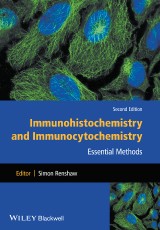Details

Immunohistochemistry and Immunocytochemistry
Essential MethodsEssential Methods 2. Aufl.
|
54,99 € |
|
| Verlag: | Wiley-Blackwell |
| Format: | |
| Veröffentl.: | 15.02.2017 |
| ISBN/EAN: | 9781118717752 |
| Sprache: | englisch |
| Anzahl Seiten: | 256 |
DRM-geschütztes eBook, Sie benötigen z.B. Adobe Digital Editions und eine Adobe ID zum Lesen.
Beschreibungen
Immunohistochemistry and immunocytochemistry are invaluable tools for the visualization of tissue and cellular antigens in diagnostic and biological research environments. The need to obtain accurate, reliable and reproducible results is paramount.<br /><br />It is with this fundamental aim in mind that we have compiled Immunohistochemistry: Essential Methods. We have achieved this by examining each aspect of immunochemistry in turn, with each chapter including detailed information regarding the subject matter in question. Each chapter is written by an expert in their field and includes protocols that are typically used in their own research. Subjects covered are, amongst others, antibodies and their production; selection of reporter labels; immunochemical staining methods and experimental design (both using single and multiple reporter labels); quality assurance; automated immunochemistry; confocal microscopy and electron microscopy. In addition, benefits and limitations of each approach are discussed within the chapters.
List of Contributors vii <p>Preface ix</p> <p>Acknowledgements xi</p> <p><b>Chapter 1: Antibodies for Immunochemistry 1</b><br /><i>Mark Cooper and Sheriden Lummas</i></p> <p>Introduction 1</p> <p>Immunogens for Antibody Production 5</p> <p>Antibody Production 12</p> <p>Antibody Purification 16</p> <p>Fragment Antibody Preparations 20</p> <p>Antibody Labelling 21</p> <p>Antibody Stability and Storage 23</p> <p>References 24</p> <p><b>Chapter 2: The Selection of Reporter Labels 25</b><br /><i>Judith Langenick</i></p> <p>Introduction 25</p> <p>Enzymatic Labels 26</p> <p>Fluorescence Detection 29</p> <p>References 32</p> <p><b>Chapter 3: Immunohistochemistry and Immunocytochemistry 35</b><br /><i>Simon Renshaw</i></p> <p>Specimen Formats for Immunochemistry 36</p> <p>Fixation 37</p> <p>Processing Tissue Blocks to Paraffin Wax 46</p> <p>Microtomy 47</p> <p>Tissue Microarrays 47</p> <p>Specimen Storage 48</p> <p>Decalcification 49</p> <p>Antigen Retrieval 50</p> <p>Controls 56</p> <p>Immunochemical Staining Techniques (Optimizing a New Antibody) 57</p> <p>Counterstains 71</p> <p>Mounting 74</p> <p>Troubleshooting 76</p> <p>Examples of Immunostaining Photomicrographs 76</p> <p>Acknowledgements 101</p> <p>References 101</p> <p><b>Chapter 4: Multiple Immunochemical Staining Techniques 103</b><br /><i>Sofia Koch</i></p> <p>Introduction 103</p> <p>Methods and Approaches 115</p> <p>References 122</p> <p><b>Chapter 5: Quality Assurance in Immunochemistry 123</b><br /><i>Peter Jackson and Michael Gandy</i></p> <p>Introduction 123</p> <p>Methods and Approaches 125</p> <p>Automated Immunochemical Staining 147</p> <p>Troubleshooting 149</p> <p>References 154</p> <p><b>Chapter 6: Automated Immunochemistry 157</b><br /><i>Emanuel Schenck and Simon Renshaw</i></p> <p>Introduction 157</p> <p>Methods and Approaches 160</p> <p>Other Forms of Automation 164</p> <p>References 168</p> <p><b>Chapter 7: Confocal Microscopy 169</b><br /><i>Ann Wheeler</i></p> <p>Introduction 169</p> <p>When Should Confocal be Used? 173</p> <p>Applications: For Example Co-localization, Quantification, 3D Visualization and Kinetics 173</p> <p>How To Set Up a Confocal Experiment? 174</p> <p>References 198</p> <p>Further Readings 198</p> <p><b>Chapter 8: Ultrastructural Immunochemistry 199</b><br /><i>Jeremy Skepper and Janet Powell</i></p> <p>Introduction 199</p> <p>Methods and Approaches 207</p> <p>References 222</p> <p>Index 227</p>
<p><b>Simon Renshaw</b> is the editor of <i>Immunohistochemistry and Immunocytochemistry: Essential Methods</i>, 2nd Edition, published by Wiley.</p>
<p>Immunohistochemistry and immunocytochemistry are invaluable tools for the visualization of tissue and cellular antigens in diagnostic and biological research environments. The need to obtain accurate, reliable and reproducible results is paramount.</p> <p><i>Immunohistochemistry and Immunocytochemistry: Essential Methods</i> is the second edition of <i>Immunohistochemisrty: Methods Express</i>, previously published by Scion Publishing. The book is a comprehensive research guide that describes the methodologies of immunochemistry. Each chapter discusses the merits and limitations of the various approaches and then provides selected tried-and-tested protocols, as well as a plethora of good theoretical information and practical advice, for immediate use at the bench. Subjects covered include, antibodies and their production; selection of reporter labels; immunochemical staining methods and experimental design (both using single and multiple reporter labels); quality assurance; automated immunochemistry; confocal microscopy and electron microscopy.</p> <p>This book offers a wealth of knowledge to the novice immunochemist, who wishes to understand fully the theory and practice of immunochemical staining techniques and obtain reliable and reproducible data time and time again. For the experienced immunochemist, it is a comprehensive reference guide, allowing optimization of existing immunochemical staining protocols and a resource to further increase knowledge and understanding.</p>
Diese Produkte könnten Sie auch interessieren:

Zukunftstechnologie Tissue Engineering

von: Will W. Minuth, Raimund Strehl, Karl Schumacher

114,99 €

Zukunftstechnologie Tissue Engineering

von: Will W. Minuth, Raimund Strehl, Karl Schumacher

114,99 €














